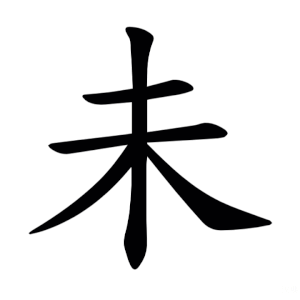未
- not, not yet;
- still incomplete, unfinished;
the 8th of the Twelve Earthly Branches (十二支), associated with the Goat/Sheep (양)
denotes time (未時: 1–3 p.m.), month (未月: lunar June), and years (e.g., 乙未, 丁未)
Etymology
Represents the thin new shoots at the tip of a tree.
Borrowed phonetically to mean “not yet.”
Usage in Korean
未來 (미래) — future
未決 (미결) — undecided, unresolved
未納 (미납) — unpaid
未完成 (미완성) — incomplete
未熟 (미숙) — immature, unripe
未婚 (미혼) — unmarried
未確認 (미확인) — unidentified (e.g. UFO 未確認飛行物體)
Words that derived from 未
Additional notes
Related negatives: 不 (부, not) and 非 (비, not / wrong), though with slightly different usage.
One of the Earthly Branches (地支): corresponds to the Goat (羊), element Earth (己土), direction southwest, and the time 未時 (1–3 p.m.).
Associated colors: golden-yellow tones.
Appears in sexagenary cycle years (干支), e.g.:
乙未 (을미) — 1895, year of the Eulmi Reform (乙未改革)
辛未 (신미) — 1871, year of the Shinmiyangyo (辛未洋擾)
Frequently contrasted with 末 (말, “end”): 未 = “not yet,” 末 = “already, end.”
Similar shape characters
Closely resembles 末 (끝 말, “end”): in 末, the upper horizontal stroke is longer; in 未, the lower one is longer.
Semantic contrast:
未 points to what is incomplete, yet to happen, still in the future.
Example: 未來 (“future”), 未決 (“unresolved”).
末 indicates completion, finality, the end.
Example: 末日 (“last day, doomsday”), 期末 (“end of a term”).
Historical note:
Both characters originally depicted the tips of tree branches.
未 - new shoots not yet matured - “not yet.”
末 - the very end of a branch - “end, tip.”
Usage in cycles:
未 is one of the 12 Earthly Branches, linked with the Goat and the lunar month 6.
末 is not part of the calendrical cycle, but commonly marks finality in time-related words.
